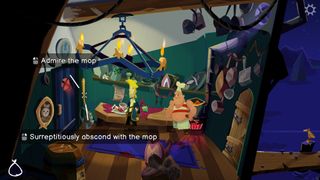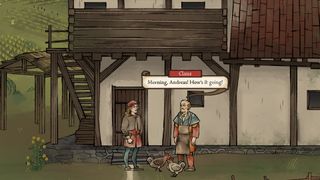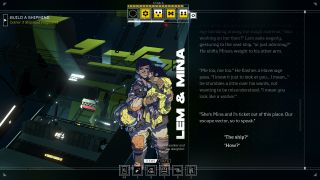2022 was a stellar year for adventure games
Pointing and clicking our way to nirvana.

The past year has seen a multi-pronged jolt of adrenaline to the adventure game genre, and not just because we got a brand new Monkey Island game. In 2022 adventure games spread their wings beyond the often formulaic confines of the hero’s journey, and it’s lovely to see more games get experimental and weird—and even sometimes appropriately vague with their endings.
It’s also been a great year to see how different games’ approaches to roleplay, choices, characterization, and exploration have empowered the genre with greater range and nuance. A good adventure isn’t about simply following a narrative thread of discoveries, but a metaphor-rich medium to explore emotion, revelation, and if you’re lucky, really good jokes. Here’s a rundown of my favorites this year.
Norco
In a year of standout adventures, there’s one still fresh in my memory—Norco. There’s been such a wealth of fantastic writing and thoughtful criticism surrounding the game, including area-specific commentary (like from @roaringblood, who lived in its neighboring town and did a great livestream playthrough), that I know Norco will survive the persistent bouts of short-term memory that afflict the industry at large. With a little distance from my last playthrough, I’ve come to think of it as a sort of freakish time capsule (filled with menacing little Garretts, of course)—a vital artefact that will persist across years before we’re all swallowed by climate change, and just a fucking brilliant piece of writing. Norco is a modern fable that takes the player deep into the decaying heart of capitalism’s worst excesses, told with heart and soul and perhaps most importantly, without completely losing its sense of hope.
When I recall a brief conversation earlier this year where someone half-jokingly scoffed at the idea of a point-and-click GOTY, I’d like to maintain the same reply: grow up and play a real game, like Norco.
Pentiment

As an ardent fan of The Name of the Rose and similar monastic-mystery novels, Pentiment was a no-brainer for me. Its careful attention to history and historiography goes well beyond the writing and into its marvelous artwork and presentation as an illuminated manuscript. The sheer scope of Andreas’ journey across time is a narrative feat, its occasional historical puzzles are an absolute delight, and if you’re a sucker for sly contextual humor, Pentiment’s sharp wit is a treat. This isn’t just another period adventure, but a wholehearted leap into the practice of storytelling, mythmaking, and the role and impact of authors.
It’s admittedly much more of a slow burn than some of the other games I mention here, but getting to know Tassing (and the quirks of the game) comes naturally once you start exploring.
Citizen Sleeper

It was also a fantastic year for narrative-driven RPGs which I also consider very much a part of adventure game canon. Citizen Sleeper, for one, was a profoundly personal journey that I soaked up quietly in the dark by the light of my monitor (I’ve hoarded all the DLCs to play for fun over the break, as a treat). I quickly developed a fraught relationship with the dice-rolling checks in the game as I struggled to survive, but in time, as I painstakingly cultivated relationships and built routines and found ways to thrive in spite of my contraband body, I didn’t want to stop (and you don’t have to).
The biggest gaming news, reviews and hardware deals
Keep up to date with the most important stories and the best deals, as picked by the PC Gamer team.
It’s a quieter flavor of adventure that speaks to exploring the intangible parts of personhood—of place, belonging, and identity—and does a beautiful job at integrating the player into the practical realities of its world.
Betrayal at Club Low
Another dice-roller I loved was Betrayal at Club Low—to be fair, I have yet to meet a Cosmo D game that I didn’t devour in one sitting, and Club Low is no different. Like most of his other games, it’s a surreal exploration of weird city life at the intersection of art and performance and music; I play a humble pizzamaker/secret agent, tasked to infiltrate the titular club and rescue a fellow spy. There’s a lot of powerful dancing, posturing, pizza delivering, and physical checks that really really hurt, all wrapped up in the loose fictional universe of Off-Peak City. Club Low, though, feels like his most engaging work to date simply because the dice checks forced me to go big or go home.
The game is, of course, less about the pie-making and more about the microcosm of the club world, and what it reveals about the city and its denizens. Club Low is a vital piece of insight into the larger enigma of Off-Peak City, a place that constantly invites inquiry but denies us the satisfaction of exploration.
AI: The Somnium Files - nirvanA Initiative

AI: The Somnium Files - nirvanA Initiative was another unconventional adventure that won my heart; the second installment refined its puzzles and escape room-style mechanics into a more coherent experience. It’s a murder mystery investigation gone wild, in which Tokyo’s secretive Advanced Brain Investigation Squad gets inside people’s dreams to solve heinous crimes. It’s almost impossible to explain the finer points of the game without sounding like a lunatic, but it’s a chaotic deep dive into conspiracy theories and bizarre half-body serial murders where nothing is really as it seems.
As with the first Somnium game (which I admittedly feel had a stronger main plot), it’s a character-driven story that hooks you with irrepressible charisma and verve, and there’s nothing quite else like it.
Pointed, clicked
Besides these delightful digressions, 2022 also just had some great straight-up point-and-click adventures. The much-awaited Excavation of Hob’s Barrow was a folk-horror treasure that did not disappoint—Wadjet Eye continues to publish quality adventures with consistently excellent voice acting and direction. Who can say no to a controversial barrow dig in rural Victorian England where you may or may not be tampering with unnatural forces? It’s a slow creeper with captivating pixel-art scenes that have been seared into my memory. On the other end of the horror spectrum was the wholly entertaining Nightmare Frames, which hews much more closely to the classic point-and-click approach to humor and self-awareness. It’s set in 1985 Hollywood, featuring a cocky screenwriting protagonist who gets involved in a freakish scavenger hunt for a cursed film. I loved every LA pixel, as well as its earnest homage to filmmaking and film culture as a whole, down to the 80s trivia arcade machine.
I also had feelings for Wayward Strand, a contemplative narrative-driven game set in an alternate version of '70s Australia on board an airship-turned-hospital. It’s dialogue-driven and focuses on immersive character studies through the eyes of a budding young writer. There’s a limit to the exploration side of adventuring—the ship is a compact, finite space, and the only way to expand the small floating world around you is by learning about its patients and its history, choosing carefully what to pay attention to. It’s also got a stellar voice cast of Australian icons, including the legendary (and instantly identifiable) Michael Caton, who dominated my school movie nights as Daryl Kerrigan in The Castle.
Finally, a shoutout to a couple of short kings. The 1.5-hour-long Gibbon: Beyond the Trees isn’t quite a conventional “adventure,” and has no dialogue, but tells a strong cohesive tale about the plight of the gibbon in the face of human greed. It takes a second to get familiar with the controls (especially using the keyboard), but it’s a great example of a short, moving narrative that hinges on momentum and the gibbon’s fluid swinging/leaping/throwing mechanics to tell a larger story about vulnerability and the gibbon’s relationship with its increasingly imperiled environment (it also feels extremely, so very bad when you miss a jump and “die”).
There Swings a Skull: Grim Tidings is an amazing little gem that walks the line between story-driven exploration and some truly bleak roleplay elements. It’s a lovely piece of existential horror wearing a pixel art mask. Set in the tiny town of Pareildes, the player lives in a sun-bleached desert outpost with a trainless station, where one by one, its people perish to a ravenous sun. It takes less than 2 hours to complete, but in that compact space of time, the game delivers an intense abundance of narrative detail with devastating economy. Highly recommended for fans of alternative horror (with some great sound design to boot), or if you’re just looking for a dark, well-written story.

Alexis Ong is a freelance culture journalist based in Singapore, mostly focused on games, science fiction, weird tech, and internet culture. For PC Gamer Alexis has flexed her skills in internet archeology by profiling the original streamer and taking us back to 1997's groundbreaking all-women Quake tournament. When she can get away with it she spends her days writing about FMV games and point-and-click adventures, somehow ranking every single Sierra adventure and living to tell the tale.
In past lives Alexis has been a music journalist, a West Hollywood gym owner, and a professional TV watcher. You can find her work on other sites including The Verge, The Washington Post, Eurogamer and Tor.
Most Popular

